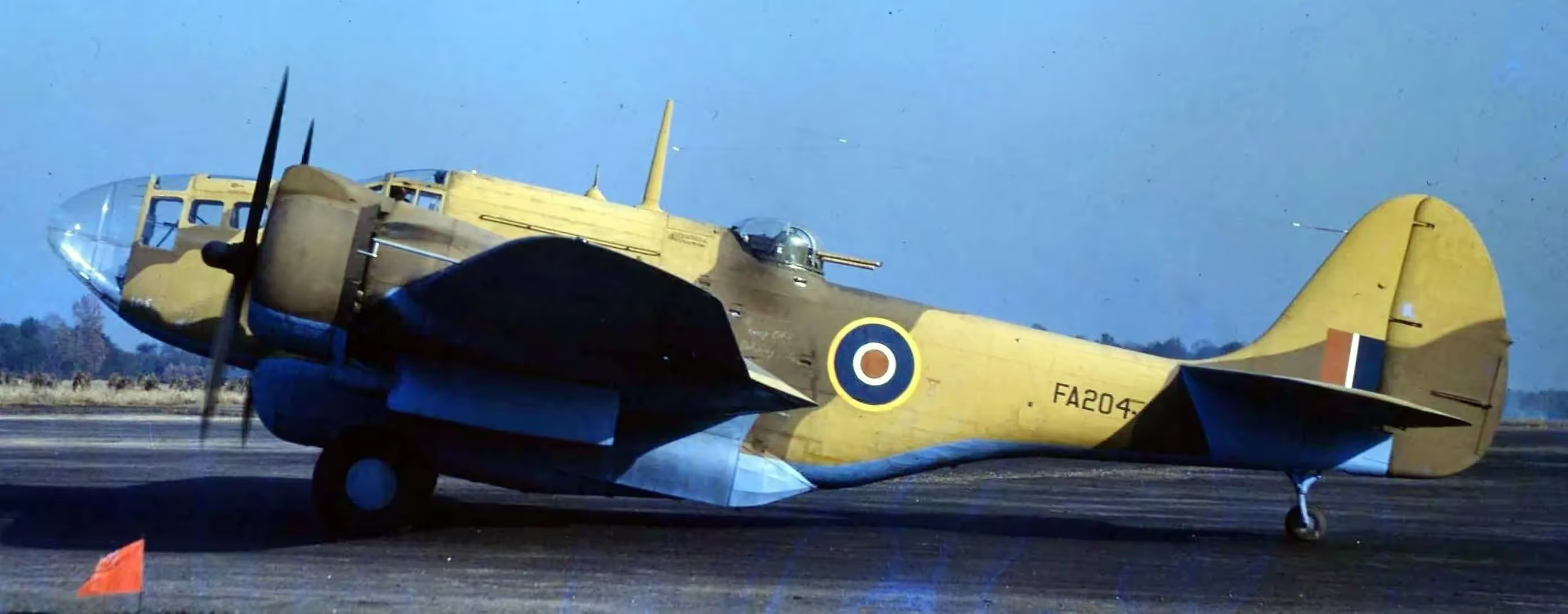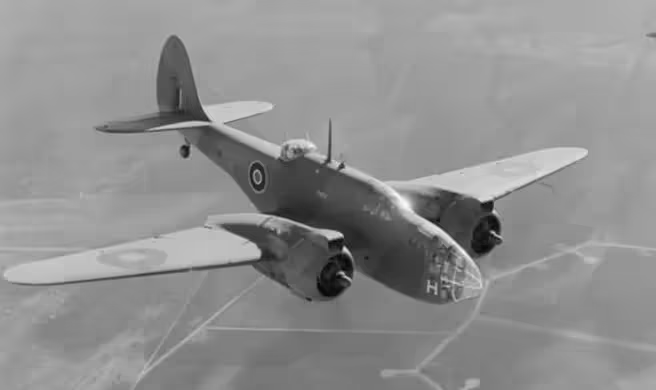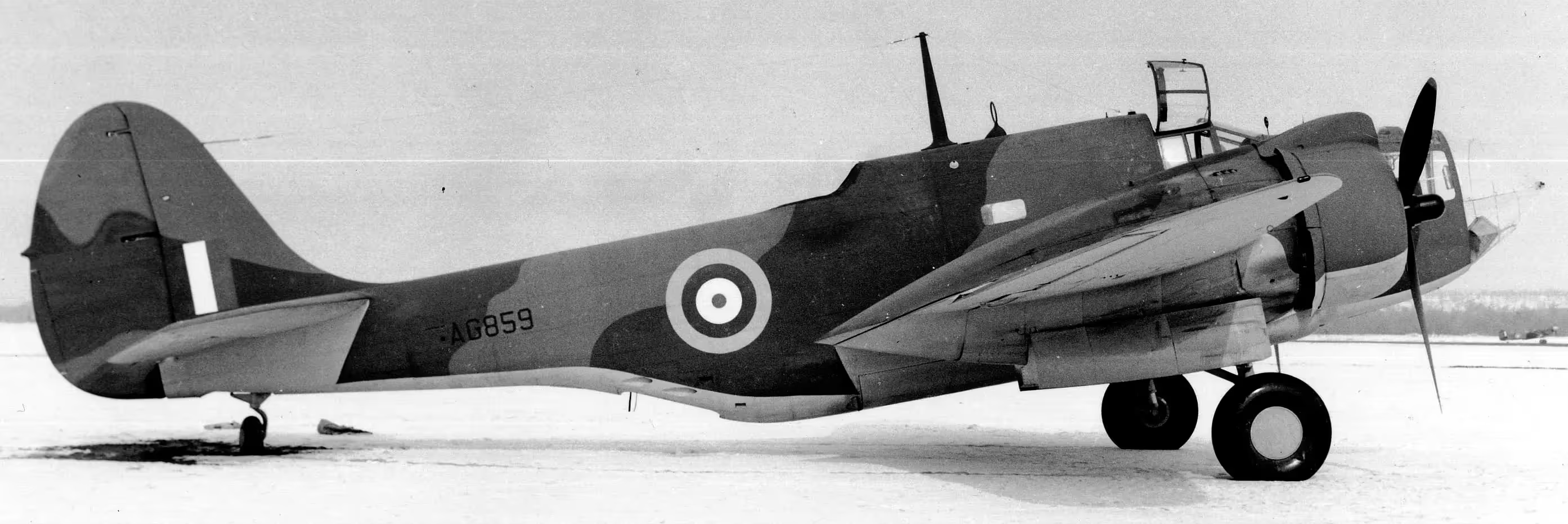Canadian Warplanes 3: Martin Baltimore
Martin Model 187 Baltimore Baltimore
.avif)
Martin Baltimore Mk. III (Serial No. FW605), RAF.
The Martin 187 Baltimore was a twin-engined light attack bomber built by the Glenn L. Martin Company in the United States as the A-30. The model was originally ordered by the French in May 1940 as a follow-up to the earlier Martin Maryland, then in service in France. With the fall of France, the production series was diverted to Great Britain and after mid-1941, supplied by the U.S. as Lend Lease equipment.
Development of the Baltimore was hindered by a series of problems, although the type eventually became a versatile combat aircraft. Produced in large numbers, the Baltimore was not used operationally by United States armed forces but eventually served with the British, Canadian, Australian, South African, Hellenic and the Italian air forces. it was subsequently used almost exclusively in the Mediterranean and Middle East theatre of the Second World War. (Wikipedia)
Martin 187 Baltimore Mk. III (1), (Serial No. FA187).
RCAF On Strength (1), Canadian Aircraft Losses (24). Detailed records of all known RCAF and Canadian casualties in the RAF during the Second World War may be viewed on line in the Canadian Aircraft Serials Personnel Information Resource (CASPIR). The CASPIR website is researched, coded, maintained entirely by Canadian Warplane Heritage Museum(CWHM) volunteers with only one staff assisting periodically. This work has taken several years, and is unlikely to be finished as continuing research leads to “new finds” and rediscovered Canadian aviation heritage and history. The CWHM volunteer team looks forward to continuing to update and correct the record as additional information and photos are received.

(World War Photos)
Martin Baltimore Mk. II (Serial No. AG793), coded “N” of No. 55 Squadron RAF, 1942.

(World War Photos)
Martin Baltimore of No. 454 Squadron RAAF, Italy, 1944.

(World War Photos)
Martin Baltimore Baltimore Mk. III (Serial No. AG837).

(World War Photos)
Martin Baltimore Mk. III (Serial No. AG837) at Boscombe Down, UK.
The Baltimore was a two-engined attack-bomber built by the Glenn L. Martin Company in the United States. To enable the aircraft to be supplied to the British under the Lend-Lease Act the USAAF designation A-30 was allocated. It was not used in combat by the United States forces, but saw service with the British, Canadian, Australian, South African, Hellenic and the Italian air forces.
In early 1940, based on the Martin 167 Maryland bombwe, the Glenn L. Martin Company began work on an improved version, the Model 187, which was to be powered by Wright R-3350-11 engines. The designers calculated its speed to be as high as 608 km/h. The US Army Air Force placed an order for a prototype, designated XA-23, but cancelled it before construction could begin. The Air Ministry set its own requirements based on the experience of the war. Work on the XA-23 was abandoned and the project was completed in accordance with British wishes. In May 1940, Glenn L. Martin Co. was contracted to deliver 400 examples of the new aircraft, which was given the name Baltimore.
Overloading the factory’s design team with work on other projects seriously delayed work on the aircraft. The prototype was supposed to take off at the beginning of 1941, but in reality it was flown on 14.06.1941. While retaining the general construction layout of the Model 167, the aircraft differed from it by having a deeper fuselage, Wright R-2600-19(A5B) engines, self-sealing fuel tanks, and light armoring of the crew positions. Technical problems meant that serial aircraft deliveries did not begin until October. In order to avoid further delays, the first aircraft had no turrets. The Mk.I (50 examples) and Mk.II (100 examples) were equipped with Wright GR-2600-19 engines. Mk.I aircraft were mainly sent to Operational Training Units, while Mk.II to combat squadrons. By the end of 1941, 146 Mk.I aircraft had reached the United Kingdom. The main part of the first order (250 units) was the Mk.III, which were fitted with Boulton Paul dorsal turrets with four British-made 7.69 mm Browning machineguns. Forty-one of these were lost in transit across the Atlantic. The last aircraft produced under the first order left the Glenn L. Martin Co. works in June 1942.
In 1941, the company was awarded another contract for 575 aircraft, but this time not directly from the British, but as part of the Lend-Lease agreement with the US government (thus received the American designation A-30 and the British Mk.IIIA). In September 1942, 600 more were ordered. Both contracts were fulfilled in full. The British received 281 copies of the Mk. IIIA (deliveries began in August 1942) and 294 copies of the Mk. IV version, which differed from the Mk. III in the type of dorsal turret. Instead of the Boulton-Paul product, they received electrically rotating Martin turrets with two Browning 12.7 mm cal. The lower rear MG was abandoned, hence the Mk.IIIA/IV crews usually flew in a three-man crew complement. The third order for 600 aircrafts was for the American A-30A and British Mk.V versions, which differed from their predecessors in that all the guns had 12.7 mm calibre and the Wright GR-2600-29 engines with greater power, thanks to which they developed greater speed. The first Mk.Vs left the Martin works in December 1942, but larger deliveries did not begin until July 1943.
The GR VI version (A-30C), intended for the British Air Force Coastal Command and equipped for patrol flights, remained only as two prototypes, built in late 1943. Martin’s proposals from 1942-1943 for a version with an elongated fuselage to accommodate additional torpedo and fuel tanks, an assault version with a solid nose to accommodate the powerful gunfire armament, and a long-range fighter version remained as drafts. Production was completed in May 1944, after 1575 examples had been built.
Many users were impressed with the change the Baltimore represented from older aircraft such as the Bristol Blenheim. Users praised the aircraft for its heavy armament, structural strength, manoeuvrability, bombing accuracy, and relatively high performance, but crews complained of cramped conditions similar to those of the earlier Maryland bomber. The narrow fuselage made it almost impossible for crew members to change position during flight in case of injury (the interior structure meant that the pilot and observer were separated from the radio operator and rear gunner). This was the case with most light bombers of the time such as the Handley Page Hampden, Douglas Boston, and Blenheim. Crews also complained about the difficulty of controlling the aircraft on the ground. On take-off, the pilot had to coordinate the controls perfectly to avoid a crash. The majority of the accidents were during the take-off and landing phases due to the aircraft’s relatively high wing loading, high approach speed and a directional stability problem during take-offs.
Bombers suffered massive losses when used as a low-level attack aircraft, especially in the chaos of the desert war where most missions were unescorted. However, operating at medium altitude with a fighter escort, the Baltimore had a very low loss rate, with the majority of losses coming from operational accidents.
Undertaking a variety of missions in the Middle East, Mediterranean and European theatres, the Baltimore’s role included reconnaissance, target towing, maritime patrol, intruder and it even served as a very uncomfortable fast transport. Used in anti-submarine role during the war, the Baltimore had moderate success, sinking up to eight submarines. The RAF also supplied aircraft to other Allies in the MTO.
Serial Nos. Mk. I: AG685-AG734, Mk. II: AG735-AG834, Mk. III: AG835-AG999, AH100-AH184, Mk. IIIA: FA100-FA380, Mk. IV: FA381-FA674, Mk. V: FW281-FW880.

(IWM Photo, ATP9982B)
Martin Model 187 Baltimore Baltimore Mk. III (Serial No. AG837), at Boscombe Down, Wiltshire in the UK. Following handling trials at the Aeroplane and Armament Experimental Establishment, AG837 was delivered to the Middle East for operational service.

(USAF Photo)
Martin Baltimore Mk. IV/V, 1941. Most Baltimores were delivered to Commonwealth countries, a few were kept in the U.S. under the USAAF designation A-30.
The first British aircraft were delivered in late 1941 to equip Operational Training Units. The RAF only used the Baltimores operationally in the Mediterranean theater and North Africa. Thrown into action to stop Rommel's advance, the Baltimore suffered massive losses when it was used as a low-level attack aircraft, especially in the chaos of the desert war where most missions went unescorted. Operating at medium altitude with fighter escorts, the Baltimore had a very low loss rate, with the majority of losses coming from operational accidents. Undertaking a variety of missions in the Middle East, Mediterranean and European theaters, the Baltimore's roles included reconnaissance, target-towing, maritime patrol, night intruder and even served as highly uncomfortable fast transports. The Baltimore saw limited Fleet Air Arm service with aircraft transferred from the RAF in the Mediterranean to equip a squadron in 1944. Used in the anti-submarine role during the war, the Baltimore achieved moderate success, sinking up to eight U-boats. The Baltimore was used intensively in the Italian campaign to clear the road to Rome for advancing Allied forces after the capitulation of Italy in 1943. (Wikipedia)

(IWM Photo, C 3975)
Baltimore Mark IV (Serial No. FA591), coded H, of No. 223 Squadron RAF in the foreground. These Baltimores of No. 232 Wing RAF of the Tactical Bomber Force, are returning to their base at Celone, Italy, after bombing enemy gun positions near Lanciano in the Sangro river battle area, 1943.

(IWM Photo, CNA 2583)
Martin Baltimore Mark IVs of No. 223 Squadron RAF based at Celone, Italy, flying in loose box formation over Italian farmland while on their way to bomb the railway station and junction at Sulmona.

(IWM Photo, CNA 2480)
Martin Baltimore Mark IV of No. 223 Squadron RAF flying over the Abruzzan Appenines after bombing a a road junction between Avezzano and Popoli on the Rome-Pescara highway, during attacks by medium bombers of the Desert Air Force on enemy supply and reinforcement routes following the Allied landings at Anzio, (Operation SHINGLE).

(IWM Photo, CNA 2477)
A Martin Baltimore Mark IV of No. 223 Squadron RAF drops 500-lb GP bombs on a road junction between Avezzano and Popoli on the Rome-Pescara highway in Abruzzo, during attacks by medium bombers of the Desert Air Force on enemy supply and reinforcement routes following the Allied landings at Anzio, (Operation SHINGLE).

(IWM Photo, CNA 2584)
Martin Baltimore Mark IV of No. 223 Squadron RAF, flying from Celone, Italy, releasing 500-lb MC bombs over the target during a raid on the railway station and junction at Sulmona.

(IWM Photo, CM 3048)
Martin Baltimore Mark I (AG697) flying past RAF Kasfareet, Egypt, during an air test, following assembly at No. 107 Maintenance Unit. AG697 served with the Strategic Reconnaissance Unit in North Africa, and was then transferred to No. 69 Squadron RAF in Malta, with whom it was lost while conducting an air-sea rescue search on 25 August 1942.

(IWM Photo, CH 14624)
A USAAF ferry crew hand over a Martin Baltimore Mark V to Flight Lieutenant A N Buell of No. 45 (Atlantic Transport) Group at Windsor Field, Nassau, Bahamas. From Nassau, the Baltimore would be flown to the Mediterranean theatre of operations, via the South Atlantic ferry route. The aircraft is fitted with a long-range fuel tank under the fuselage.

(IWM Photo, TR 850)
A Flight Lieutenant bomb-aimer of No 223 Squadron, Royal Air Force checks over his bomb sight in Martin Baltimore aircraft `N-NAN'. The open bomb-bay doors give a glimpse of general purpose 250-pounder bombs.

(IWM Photo, CNA 2581)
Martin Baltimore Mk. IV (Serial No. FA463), coded U, of No. 223 Squadron RAF, on the ground at Celone, Italy, after completing 102 operational sorties with the Squadron over Tunisia, Sicily and Italy. 'U' for Uncle's total flying time on its retirement from operations amounted to 313.50 hours.

(IWM Photo, CH 14632)
Martin Baltimore Mark IV taxies to its dispersal in a cloud of dust after landing at Accra, Gold Coast, while flying the South Atlantic ferry route from Nassau, Bahamas, to Cairo. Note the long-range fuel tank fitted under the fuselage of the aircraft.

(IWM Photo, ATP10635D)
Martin Model 187 Baltimore Mk. I (Serial No. AG688), at the Burtonwood Repair Depot, Lancashire.

(Library and Archives Canada Photo, MIKAN No. 3607736)
Martin 187 Baltimore, (Serial No. FA647), RAF.

(Shearwater Aviation Museum Photo)
Martin 187 Baltimore Mk. III, RAF (Serial No. AG859).

(Shearwater Aviation Museum Photo)
Martin 187 Baltimore Mk. III, RAF (Serial No. AG859)

(USAAF Photo)
Martin Martin Baltimore Mk. I or II, 14 June 1941.

(IWM Photo, CNA 2599)
The crew of a Martin Baltimore Mk. IV of No. 223 Squadron RAF, walk from their aircraft (FA394) at Celone, Italy, after successfully completing a bombing sortie to enemy targets in the Popoli area. They are, (left to right): Sergeant S A Jupp (pilot), of Gravesend, Kent Flight Sergeant W G Gidley (navigator), of Callington, Cornwall Sergeant W.A. Airth (air gunner), of Hamilton, Lanarkshire Warrant Officer J.W. Simpson (wireless operator), of Sydney, Australia.

(World War Photos)
Martin Baltimore Mk. V (Serial No. FW494), Bari, 1945.

(World War Photos)
Martin Baltimore Mk. IV (Serial No. FA463), coded “U” of No. 223 Squadron RAF, at Celone, Italy.

(World War Photos)
Martin Baltimore nose view, No. 223 Squadron RAF.

(USAF Photo)
Martin A-30 prior to delivery.
In post-war service, the Baltimore took part in United States Navy instrument and control surface tests in the effort to break the sound barrier. With its powerful engines and light, yet robust construction, the aircraft was able to be dived at high speed, reaching Mach .74 in tests. All Baltimores were withdrawn from service by the end of 1949, the last one being retired on 23 December 1949.

(USAAF Photo)
Martin Baltimore GR. IIIA (Serial No. FA105) variant equipped with a Martin dorsal turret housing twin .50-caliber M2 machine guns, supplied to the British under the Lend-Lease program, 1942.

(World War Photos)
Martin Baltimore over its target. Note the bombs exploding on the ground below.

(RAF Photo)
A formation of Martin Baltimores of No. 232 Wing RAF flying to attack enemy positions during the Battle of El Alamein, seen through the lower gun hatch of another aircraft.





